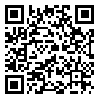Volume 10, Issue 4 (2011)
QJER 2011, 10(4): 41-67 |
Back to browse issues page
Download citation:
BibTeX | RIS | EndNote | Medlars | ProCite | Reference Manager | RefWorks
Send citation to:



BibTeX | RIS | EndNote | Medlars | ProCite | Reference Manager | RefWorks
Send citation to:
Moradi M A, Tajick Khaveh M. Money Demand and Seigniorage in Iran: 1342-1386. QJER 2011; 10 (4) :41-67
URL: http://ecor.modares.ac.ir/article-18-4655-en.html
URL: http://ecor.modares.ac.ir/article-18-4655-en.html
1- Ph.D. in Economics, Entrepreneurship Faculty, Tehran University
2- MA. in Economics, Science and Research University
2- MA. in Economics, Science and Research University
Abstract: (5868 Views)
Due to the poor development of the domestic financial markets in Iran, a lack of efficient tax system and some restrictions on foreign borrowing in recent decades, the government budget deficit was mainly financed through borrowing from either the central bank or through the selling of the oil revenue dollars to the central bank, both of which led to increased monetary base. It caused to increase the rate of inflation as well. While printing money creates revenue through seigniorage for the government, it decreases the purchasing power of the money and people prefer to hold less cash money because of the inflationary effects of monetization of budget deficit and finally it will reduce the seigniorage revenue of the government.
The aim of this article is to analysis seigniorage revenue in Iran using money demand function approach. The Johansen-Juselius Cointegration technique is used to estimate the empirical model using annual data over the period 1961-2007. The results of estimates show that semi elasticity of inflation rate is negative of 5/59 and the elasticity of GDP per capita is positive of 2/36 in long run. After first oil boom, seigniorage-maximizing rate of inflation, except during the period of war, is lower than the actual rate of inflation. According to the result, the economy is generally on the wrong side of the Laffer curve. The result does not depend on whether the expectations of agents form adaptively or rationally.
Received: 2010/02/22 | Accepted: 2010/11/7 | Published: 2010/12/31
| Rights and permissions | |
 |
This work is licensed under a Creative Commons Attribution-NonCommercial 4.0 International License. |







